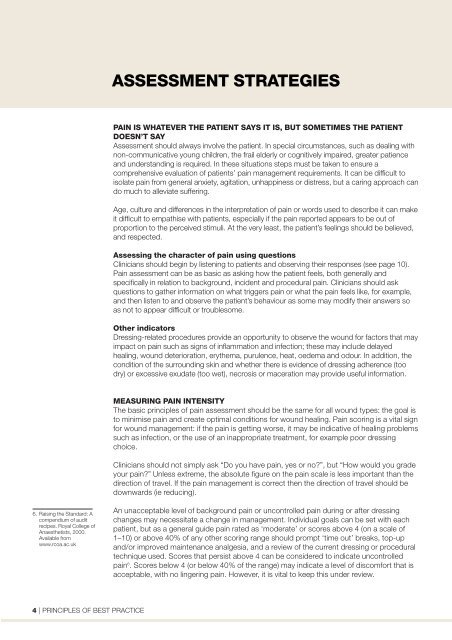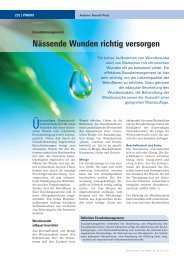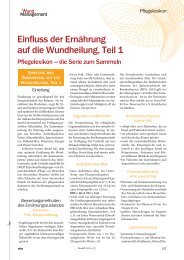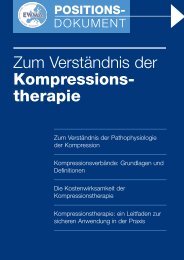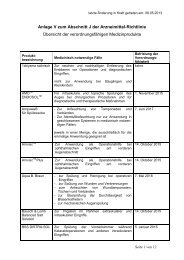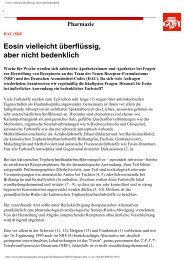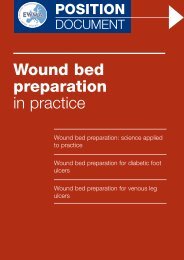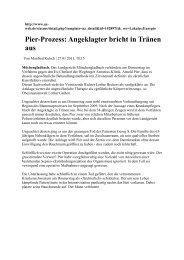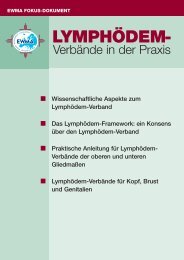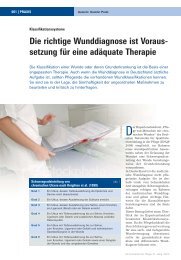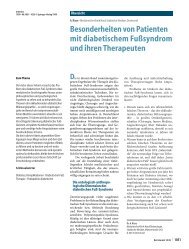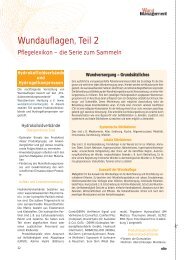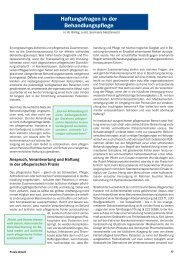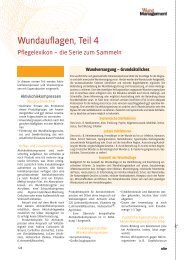Minimising pain at wound dressing-related procedures A ... - Less Pain
Minimising pain at wound dressing-related procedures A ... - Less Pain
Minimising pain at wound dressing-related procedures A ... - Less Pain
You also want an ePaper? Increase the reach of your titles
YUMPU automatically turns print PDFs into web optimized ePapers that Google loves.
ASSESSMENT STRATEGIES<br />
PAIN IS WHATEVER THE PATIENT SAYS IT IS, BUT SOMETIMES THE PATIENT<br />
DOESN’T SAY<br />
Assessment should always involve the p<strong>at</strong>ient. In special circumstances, such as dealing with<br />
non-communic<strong>at</strong>ive young children, the frail elderly or cognitively impaired, gre<strong>at</strong>er p<strong>at</strong>ience<br />
and understanding is required. In these situ<strong>at</strong>ions steps must be taken to ensure a<br />
comprehensive evalu<strong>at</strong>ion of p<strong>at</strong>ients’ <strong>pain</strong> management requirements. It can be difficult to<br />
isol<strong>at</strong>e <strong>pain</strong> from general anxiety, agit<strong>at</strong>ion, unhappiness or distress, but a caring approach can<br />
do much to allevi<strong>at</strong>e suffering.<br />
Age, culture and differences in the interpret<strong>at</strong>ion of <strong>pain</strong> or words used to describe it can make<br />
it difficult to emp<strong>at</strong>hise with p<strong>at</strong>ients, especially if the <strong>pain</strong> reported appears to be out of<br />
proportion to the perceived stimuli. At the very least, the p<strong>at</strong>ient’s feelings should be believed,<br />
and respected.<br />
Assessing the character of <strong>pain</strong> using questions<br />
Clinicians should begin by listening to p<strong>at</strong>ients and observing their responses (see page 10).<br />
<strong>Pain</strong> assessment can be as basic as asking how the p<strong>at</strong>ient feels, both generally and<br />
specifically in rel<strong>at</strong>ion to background, incident and procedural <strong>pain</strong>. Clinicians should ask<br />
questions to g<strong>at</strong>her inform<strong>at</strong>ion on wh<strong>at</strong> triggers <strong>pain</strong> or wh<strong>at</strong> the <strong>pain</strong> feels like, for example,<br />
and then listen to and observe the p<strong>at</strong>ient’s behaviour as some may modify their answers so<br />
as not to appear difficult or troublesome.<br />
Other indic<strong>at</strong>ors<br />
Dressing-rel<strong>at</strong>ed <strong>procedures</strong> provide an opportunity to observe the <strong>wound</strong> for factors th<strong>at</strong> may<br />
impact on <strong>pain</strong> such as signs of inflamm<strong>at</strong>ion and infection; these may include delayed<br />
healing, <strong>wound</strong> deterior<strong>at</strong>ion, erythema, purulence, he<strong>at</strong>, oedema and odour. In addition, the<br />
condition of the surrounding skin and whether there is evidence of <strong>dressing</strong> adherence (too<br />
dry) or excessive exud<strong>at</strong>e (too wet), necrosis or macer<strong>at</strong>ion may provide useful inform<strong>at</strong>ion.<br />
MEASURING PAIN INTENSITY<br />
The basic principles of <strong>pain</strong> assessment should be the same for all <strong>wound</strong> types: the goal is<br />
to minimise <strong>pain</strong> and cre<strong>at</strong>e optimal conditions for <strong>wound</strong> healing. <strong>Pain</strong> scoring is a vital sign<br />
for <strong>wound</strong> management: if the <strong>pain</strong> is getting worse, it may be indic<strong>at</strong>ive of healing problems<br />
such as infection, or the use of an inappropri<strong>at</strong>e tre<strong>at</strong>ment, for example poor <strong>dressing</strong><br />
choice.<br />
Clinicians should not simply ask “Do you have <strong>pain</strong>, yes or no?”, but “How would you grade<br />
your <strong>pain</strong>?” Unless extreme, the absolute figure on the <strong>pain</strong> scale is less important than the<br />
direction of travel. If the <strong>pain</strong> management is correct then the direction of travel should be<br />
downwards (ie reducing).<br />
6. Raising the Standard: A<br />
compendium of audit<br />
recipes. Royal College of<br />
Anaesthetists, 2000.<br />
Available from<br />
www.rcoa.ac.uk<br />
An unacceptable level of background <strong>pain</strong> or uncontrolled <strong>pain</strong> during or after <strong>dressing</strong><br />
changes may necessit<strong>at</strong>e a change in management. Individual goals can be set with each<br />
p<strong>at</strong>ient, but as a general guide <strong>pain</strong> r<strong>at</strong>ed as ‘moder<strong>at</strong>e’ or scores above 4 (on a scale of<br />
1–10) or above 40% of any other scoring range should prompt ‘time out’ breaks, top-up<br />
and/or improved maintenance analgesia, and a review of the current <strong>dressing</strong> or procedural<br />
technique used. Scores th<strong>at</strong> persist above 4 can be considered to indic<strong>at</strong>e uncontrolled<br />
<strong>pain</strong> 6 . Scores below 4 (or below 40% of the range) may indic<strong>at</strong>e a level of discomfort th<strong>at</strong> is<br />
acceptable, with no lingering <strong>pain</strong>. However, it is vital to keep this under review.<br />
4 | PRINCIPLES OF BEST PRACTICE


